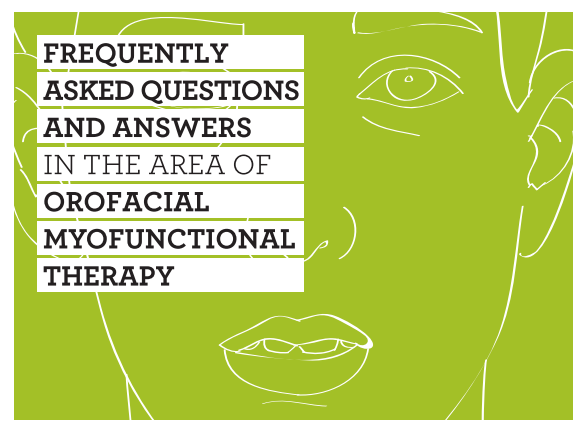
Orofacial Myofunctional Therapy
Support for orofacial myofunctional disorders
At Lene On Me – Speech Therapy Services, the goal of orofacial myofunctional therapy is to train the muscles of the face and mouth to rest in the correct position and function in harmony to have a positive impact on facial growth and development, breathing, speech, dental health, and more.
-
An orofacial myofunctional disorder (OMD) describes any irregularities in the form and function of the muscles of the face and mouth (i.e., how the muscles of the face and mouth are used for eating, talking, and breathing). They may also include dental or skeletal structures that could affect normal growth and development.
OMDs can occur throughout the lifespan and may present differently in different age groups.
-For younger children, oral habits and/or difficulty with feeding or chewing may be seen.
-In children, adolescents, and adults, symptoms may include:
impaired speech production
mouth breathing
tongue thrust swallow
improper jaw growth and/or malocclusion (bite misalignment)
facial pain
sleep disordered breathing/ apnea
improper body alignment/posture
persistent food aversions
For additional signs & symptoms of OMDs, click here.
DIAGNOSIS
A diagnosis of orofacial myofunctional disorder would need to include one or more of the following conditions:
poor nasal breathing
abnormal lip and/or tongue rest posture (e.g., open-mouth, low/forward tongue)
lip incompetence (an inability to maintain a lips-together, closed-mouth posture at rest and showing strain in the muscles around the face when a lip seal is attempted)
tongue protrusion while swallowing (also known as a “tongue thrust swallow”)
poor chewing and food management
oral habits (e.g., cheek/nail biting, thumb/finger sucking, etc.)
bruxism (teeth grinding)
atypical oral placement for speech sounds
You can also learn more here:
• American Speech-Language-Hearing Association (ASHA)
-
My assessment process typically involves working with the client/ the client’s family to gather a comprehensive case history (e.g., information regarding pregnancy, birth, and development), followed by assessments of the orofacial complex (i.e., the muscles of the face and mouth) and, if necessary, articulation (i.e., how speech sounds are produced using the tongue, teeth, lips, jaw, vocal cords, etc.).
When appropriate, collaboration with other professionals may occur for additional insight into possible contributing factors. This may include identifying
AIRWAY PATENCY (i.e., the ability of a person to breathe). Does the client have enlarged tonsils or adenoids, allergies, or blocked nasal passages?
DENTAL OR ORTHODONTIC CONCERNS. Does the client have teeth misalignment, tethered oral tissues (i.e., tongue-tie, lip-tie, buccal ties), or a high-arched and/or narrow palate?
ORAL HABITS. Does the client have any habits such as thumb/finger sucking, lip sucking/biting, and/or nail biting?
-
Treatment of orofacial myofunctional disorders may be referred to as orofacial myofunctional therapy (OMT), although it can also be known as orofacial myology or myofunctional therapy.
OMT involves therapeutic exercise-based techniques, based on the principles of motor learning and neural plasticity, to stabilize, tone, strengthen, or improve the range of motion of the skeletal muscles of the face and neck used to treat a range of orofacial myofunctional disorders.
OMT is a neuromuscular re-education of the muscles in the face, lips, mouth, tongue, and neck. Therapy focuses on oral habit elimination, habituation of nasal breathing, correct oral rest posture, and oral phase swallow. This supports airway development and optimal oral and facial muscle function, balance, and development.
Simply put, ‘orofacial’ refers to the face and mouth region while ‘myology’ is the area of medicine that is focused on muscles and how they work. Together, these two words refer to healthcare that addresses problems of the face, jaw, and mouth by working with patients’ muscles.
-
Muscles that rest in the correct position and function in harmony will have a positive impact on facial growth and development, breathing, speech, dental health, and more. Based on this premise, orofacial myofunctional therapy is an individualized treatment program that aims to coordinate muscle function and breath support for feeding and swallowing.
Therapy begins with a series of isolated exercises to target under-utilized muscles and retrain incorrect movement patterns and quickly progresses to functional feeding and swallowing activities that carry over into daily life. These simple exercises are recommended to be done every day until proper muscle function is achieved.
In order to provide the most effective and integrated care, an important aspect of orofacial myofunctional therapy is the multidisciplinary team approach involving collaboration with a client’s doctor, dentist, orthodontist, ENT/Otolaryngologists, occupational therapist, physiotherapist, etc.
-
Orofacial myofunctional therapy is about changing habits, behaviours, and muscle patterns to improve the way someone speaks, breathes, chews, swallows, and rests their mouth.
Depending on the nature of the identified disorder and corresponding goals, therapy may include isolated exercises to target under-utilized muscles and retrain incorrect movement patterns, conversation, and/or eating-related activities (e.g., chewing, sucking, drinking, swallowing).
Clients will also be given specific, personalized activities to practice at home. These simple exercises are recommended to be done every day until proper muscle function is achieved. Various tools and tasks will be incorporated into these sessions; however, the main goal is to keep therapy as functional as possible to improve successful outcomes and more easily incorporate home programming into daily life.
Therapy is typically 30- to 60-minute weekly sessions covering main goal areas. As therapy progresses and we begin to fade treatment, the frequency of sessions gradually reduces (e.g., bi-weekly, monthly, bi-monthly, etc.).
-
Some example of orofacial myofunctional therapy goals include:
normalizing tongue and lip resting postures
re-establishing nasal breathing patterns
eliminating improper chewing and swallowing patterns
stabilizing the dentition from extraneous orofacial muscle movement
addressing harmful oral habits including:
prolonged pacifier use
thumb and/or finger sucking fingernail, cheek, or lip biting
tongue sucking
clenching or grinding of the teeth
-
The duration of orofacial myofunctional therapy varies based on the severity of the disorder, family support, completion of the home program, and any contributing factors (e.g., persistent allergies, orthodontic plans).
As proper muscle function involves retraining the brain and spinal cord in both voluntary and reflexive motor activities, this takes commitment by the client, their family, and the therapist – and it takes time. We usually start with weekly therapy and then determine what is needed based on how the client responds to treatment. Orofacial myofunctional therapy typically starts with a block of 6 to 18 sessions. While the time and effort may at first seem daunting, the reward is a lifetime of better health.
There are various factors that may impact the prognosis for treatment and length of intervention. These include:
Motivation - Success in therapy is directly and inescapably dependent upon the individual’s motivation, cooperation, and self-discipline with the home assignments.
Family involvement and encouragement is essential. Depending on the age of a client, parents/caregivers may be required to participate in the therapy sessions with their child, to learn the exercises and assist in the daily exercises at home.
Age and maturity of the individual.
Attention span of the individual.
Attitude of the individual and parents.
Completion of the home program.
Contributing factors (e.g., persistent allergies, structural deviations, orthodontic plans)
Dedication and consistency are key to success and lasting results.
-
If you’re wondering if your child may have an orofacial myofunctional disorder, use the self-check section to assess whether they may benefit from a consultation.
-
If you’re wondering if you may have an orofacial myofunctional disorder, use the self-check section to assess whether you may benefit from a consultation.
-
Some oral habits, such as thumb and finger sucking, can begin as early as in the womb and are considered very normal during infancy. Many children have these habits for the first few years of their life, then stop on their own. However, if oral habits continue beyond 3 or 4 years of age, there can be a negative impact on tongue placement, jaw shape, teeth position, breathing, and speech development.
Despite knowing about the negative impact of oral habits, the process of habit elimination is difficult -at any age. To support this process, I provide guidance and proven strategies (e.g., the Simon Says Thumbs Up Habit Elimination program) to help clients stop an undesired oral habit. With diligence, many clients often successfully stop their habit within four weeks.
-
For those undergoing surgery for tethered oral tissues (e.g., a “tongue tie” or “lip tie”), pre- and post-frenectomy therapy sessions are recommended to allow the muscles to function and rest correctly and to support an optimal surgical outcome.
The term tethered oral tissues (TOTs) refers to restrictive tissue in the mouth that impacts how a person is able to use their mouth. A well-known example of this is a tongue tie, a congenital condition known as ankyloglossia, which restricts the movement of the tongue. It is estimated that almost 5% of children are born with a tongue tie that can impact their tongue movement for breastfeeding and speech.
It is important to note that the presence of a fold of tissue (frenulum) under the tongue, lips, or around the cheeks does not mean that these structures are “tied.” In order to be considered a true tie, the frenulum needs to affect the functioning of the body.
Examples of possible functional impacts of TOTs include difficulties with breastfeeding and bottle feeding, chewing/swallowing, speech production, sleep, breathing, and body movement or posture. It’s also important to know that there are many symptoms of TOTs and not everyone will have the same symptoms!
Once a diagnosis of a lingual (tongue) tie is made, an oral procedure such as a frenectomy can be used (if desired) to release an overly large, tight, or poorly positioned lingual frenulum to allow for more normal movement of the tongue. (Note: Other terms may include frenuloplasty, frenulectomy, frenulotomy, or frenotomy).
Before surgery is scheduled, pre-frenectomy myofunctional therapy is recommended to begin increasing mobility and strength of the tongue for a more successful surgery. Once myofunctional therapy clearance is given, the client is referred to a frenectomy provider.
After the frenectomy, the tissue under the tongue can reattach if not stretched or exercised properly. Therefore, after the frenectomy procedure, further myofunctional therapy is recommended to regain proper function, correct rest posture of the tongue, and to prevent the tissue from reattaching.
-
When there is a combination of an orofacial myofunctional disorder (OMD) and a related speech error, it is often difficult to correct the speech problem through traditional speech therapy, until the OMD has been corrected.
For example, in the event that a tongue thrust pattern is causing articulation or swallowing difficulties, a speech-language pathologist can help develop and implement an intervention program to correct these difficulties.
The goal of treatment is to set the client up for orthodontic success and retention, improve swallowing patterns, and facilitate readiness for successful articulation therapy.
Signs & Symptoms of Orofacial Myofunctional Disorder.
OMDs can occur throughout the lifespan and may present differently in different age groups.
WHO CAN BENEFIT FROM OROFACIAL MYOFUNCTIONAL THERAPY?
If you’re wondering if you, or your child, could benefit from orofacial myofunctional therapy, click on the appropriate button below to take you to a self-check questionnaire.
If any of these issues concern you, you may want to make an appointment for a consult.
